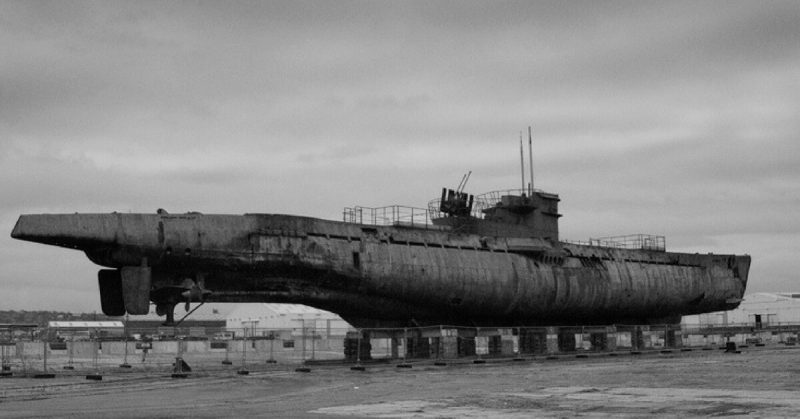In 1958, a German submarine was hoisted from the depths of the Kattegat Bay between the North and Baltic Seas off the coast of Sweden. The U-boat had been resting there for 13 years.
The German submarine, the U-843, was a Type IXC/40 used by the Kriegsmarine from 1942–45. Kapitanleutnant Oskar Herwatz commanded the ship through three patrols. The sub’s greatest success was sinking the Nebraska, a British ship hauling merchant goods. That sinking resulted in two lost Nebraska crewmen. Thankfully, the rest of the ship’s crew and passengers were saved.
The U-843’s fourth patrol was its last. It had sustained damage to its torpedo tubes in April 1944 from an American B-24 bomber attack. It was sunk a year later, after a long haul from the East Indies, around the Cape, and back up to the waters of Scandinavia.
The U-843 was just west of Gothenburg, Sweden when it was attacked and hit with rockets from an RAF 235 Squadron de Havilland DH 98 Mosquito. The damage sustained during the assault was not extensive, so Captain Herwatz went on deck to supervise repairs. Suddenly, to his horror the ship capsized and sank, leaving only 13 survivors from a crew of 58 men.
The wreckage was discovered by a diver in 1947 but was not raised until 1958. Herwatz had survived the sinking and was on hand to assist in the recovery.
The boat itself was not worth much, but the cargo was. The goods it had been carrying from Batavia (present day Jakarta in Indonesia) included rubber, tin, molybdenum, and opium. To raise the boat cost around £20,000. The contents were worth £80,000 – making the raising of the sub well worth the effort. It took three weeks to complete the job.
Although submarines were a key feature of naval conflict during the Second World War, earlier examples of this technology can be found as far back as the mid 1800’s. Today, submarines are an essential element in navies across the globe, but it was in Germany that concept of a submergeable military vessel first appeared.
In 1850, more than six decades before they began earning a reputation as deadly war machines, a German ex-cavalryman and engineer named Wilhelm Bauer was working on his groundbreaking early submarine designs. At the time, the country’s sea ports were being blockaded by Denmark, and Bauer hoped that his new creation – referred to as a Brandtaucher, which means “Fire Diver” – could help tackle that situation.
Officials in the navy were interested in the idea, and gave him the funding he needed to make a full-sized prototype. However, they were not willing to give him quite enough money to build it to his own high standards, and so some corners had to be cut.
Most likely as a result of this, when the Brandtaucher was put to the test in Kiel Harbour, it sank beneath the waves and settled on the seabed. Bauer himself barely escaped with his life, and the project was shelved – for the time being, at least.
More than half a century later, the First World War saw the true potential of this technology unleashed. Germany built a fleet of U-boats and waged a deadly campaign against Great Britain, pushing their enemies to the edge of their endurance. The plan was to attack commercial ships and trading vessels, in the hope that, without supplies and imports, Britain would eventually be forced to surrender.
This backfired, however, when Germany torpedoed and destroyed three American ships. As a direct result of this act of aggression, the United States entered the war. The Allies soon managed to sweep back across Europe, defeating the German Kaiser’s forces and ending the war.
Of course, only 21 years later, the Second World War broke out in 1939, and submarines were once again in action. By this time numerous other nations had developed their own versions the Germans’ ground-breaking technology, and U-boat warfare became even deadlier than before.
Check out the video below to explore the recovered U-843.
https://www.youtube.com/watch?v=EoJto7mKmXk
